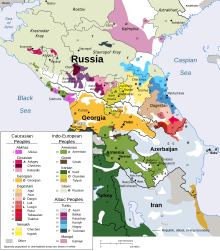This article needs additional citations for verification. (August 2009) |
| Nogai | |
|---|---|
| ногай тили, ногайша (nogay tili, nogayşa) | |
 | |
| Native to | Russia, Romania, Bulgaria, Turkey, Kazakhstan, Ukraine, Uzbekistan |
| Region | Caucasus |
| Ethnicity | 108,000 Nogais (2020 census)[1] |
Native speakers | 86,000 (2020 census)[1] |
Turkic
| |
| Cyrillic, Latin[2] | |
| Official status | |
Official language in | |
| Language codes | |
| ISO 639-2 | nog |
| ISO 639-3 | nog |
| Glottolog | noga1249 |
| ELP | Noghay |
| Alabugat Tatar[3] | |
 Nogai is classified as Definitely Endangered by the UNESCO Atlas of the World's Languages in Danger[4] | |

Nogai (/noʊˈɡaɪ/ noh-GHY; Ногай тили, Nogay tili, Ногайша, Nogayşa) also known as Noğay, Noghay, Nogay, or Nogai Tatar, is a Turkic language spoken in Southeastern European Russia, Kazakhstan, Uzbekistan, Ukraine, Bulgaria, Romania and Turkey. It is the ancestral language of the Nogais. As a member of the Kipchak branch, it is closely related to Kazakh, Karakalpak and Crimean Tatar. In 2014 the first Nogai novel (Akşa Nenem) was published, written in the Latin alphabet.[5]
- ^ a b Nogai at Ethnologue (26th ed., 2023)

- ^ "türkevi araştırmalar merkezi". www.turkevi.org. Retrieved 2024-01-28.
- ^ Endangered Languages Project data for Alabugat Tatar.
- ^ "Nogai in Russian Federation". UNESCO WAL. Retrieved 23 July 2024.
- ^ "İlk Nogayca roman kitabı yayınlandı… – türkevi araştırmalar merkezi".